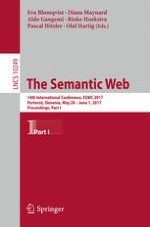The two volumes LNCS 10249 and 10250 constitute the refereed proceedings of the 14th International Semantic Web Conference, ESWC 2017, held in Portorož, Slovenia.The 51 revised full papers presented were carefully reviewed and selected from 183 submissions. In addition, 10 PhD papers are included, selected out of 14 submissions. The papers are organized in the following tracks: semantic data management, big data, and scalability; linked data; machine learning; mobile web, sensors, and semantic streams; natural language processing and information retrieval; vocabularies, schemas, and ontologies; reasoning; social web and web science; semantic web and transparency; in use and industrial track; and PhD symposium.
